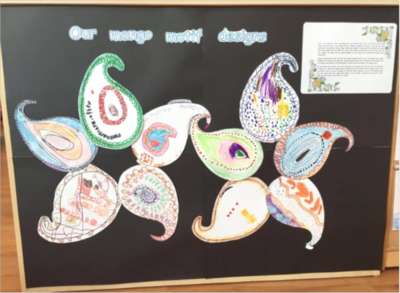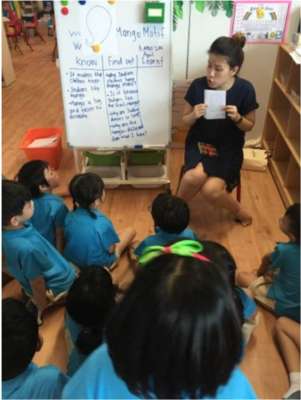"Maharaja Mangoes" • MOE Kindergartens @ West Spring
Overview
|
Learning Areas |
Learning Goals |
|
Aesthetics and Creative Expression (A&C) |
LG3: Create art and music and movement using experimentation and imagination |
|
Discovery of the World (DOW) |
LG2: Find out why things happen and how things work through simple investigation |
|
Language and Literacy (L&L) |
LG2: Speak to convey meaning and communicate with others |
| Refer to the Nurturing Early Learners (NEL) Educators’ Guide, Volume 1 pp. 41 to 49, for more information on planning for field trips. |
Learning Objectives:
- Find out more about the mango motif used in Indian artefacts and accessories
- Talk about what they have learnt from the field trip
- Design their own mango motif using a line/shape in a repeated manner
- Suggest sentences for a class story about the field trip
#1 Before the field trip: Inviting interest
How?
1. Use a stimulus that is related to the field trip and plan a hands-on activity to pique your children’s interest.
For example:
Children are learning about the people of Singapore as part of the theme “Who are the people around me?” Show them authentic Indian accessories which have the mango motif on them. You can also bring a real mango to class and get the children to compare it to the shape of the mango motif.| Did you know that the mango is the national fruit of India? In fact, many Indian artefacts and accessories are decorated with the mango motif (paisley pattern)! This lesson uses the mango motif as a stimulus to pique children’s interest and as the focal point for the field trip to Little India. |
2. Encourage the children to ask questions related to the stimulus to nurture their sense of wonder and curiosity.
For example:
Model how children can ask questions. Organise their questions using a graphic organiser such as a question wall or a KWL chart.
| Graphic organisers provide visual representation of concepts and ideas. Use them to guide children through the thinking process and to make their thinking visible. A KWL chart features three columns: “K” is for recording what children already Know about a topic, “W” is for recording what children Want to know about the topic and, “L” is for what children have Learnt in that topic (Ogle, 1986). |
3. Discuss with your children what they should look out for during the field trip.
For example:
Using the children’s questions, help them to focus on what they would like to find out during the field trip to Little India. Assign questions to selected children and have them prepare question cards/cues to help them in their task. You can also get your children to prepare for a “mango motif hunt”. Let them create their own “mango motif finder” to help them in their search during the field trip.
Additional tips for planning a field trip: 1. Reccé the place beforehand.
2. Always seek parental consent. 3. Plan for wet weather. 4. Take note of bus drop-off points |
#2 During the field trip: Facilitating learning
Facilitate your children’s learning during the field trip.
How?
- Remind your children about their task (e.g. get your children to use their “mango motif finder” to look for the mango motif on Indian accessories and other artefacts).
- Encourage your children to find answers to their questions (e.g. have them ask the shopkeepers questions from their list).
- Encourage your children to use their senses to observe the environment and experience the atmosphere during the field trip. Point out interesting things to them.
- Take photographs of what your children experienced during the trip.
 |
 |
Children finding the mango motif at Little India
#3 After the field trip: Consolidating learning
Help your children to consolidate what they have learnt from the field trip.
How?
- Refer to the children’s questions on the question wall/KWL chart and have them talk about what they have learnt. Record their answers on the question wall/ KWL chart.
- Plan activities for your children to apply what they have learnt during the field trip.
For example:
Write a class story about the children’s experience in Little India (use photographs to help them to recall what they did and saw there). Children can also create an artwork that reflects their learning in Little India such as designing their own mango motif.

Examples of children’s mango motif designs

